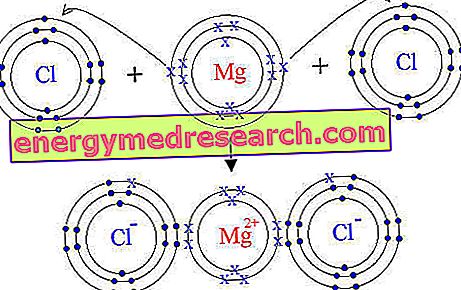Magnesium is naturally found in the form of magnesium salts, due to its high reactivity.
If we look at the electronic configuration of this chemical element we note the presence of two electrons in the outermost orbital; these electrons are easily transferred to other chemical elements that need electrons to complete their external energy level; the magnesium deprived of two electrons results positively charged → magnesium ion Mg ++; if instead we observe the electronic configuration of chlorine we notice the presence of seven electrons in the outer orbital; therefore, chlorine tends to attract an electron eagerly to itself, so as to complete the octet; in this way, once the missing electron is acquired, it is called Cl-ion chlorine. This explains how magnesium chloride (Mg Cl 2 ) is formed.

After this brief chemical digression, we briefly see the health characteristics of the various magnesium salts.
The first characteristic to consider when evaluating a health-giving magnesium salt is the quantity of elemental magnesium contained in it; in the above case, it is evident that a gram of magnesium chloride contains a certain percentage of elemental chlorine and a certain amount of elemental magnesium.
| Magnesium ion content in various magnesium compounds (hydrates) | |
| Magnesium salt | Grams of magnesium per gram of the compound |
| Magnesium Oxide | 0.600 g |
| Magnesium Citrate | 0.160 g |
| Magnesium chloride | 0.120 g |
| Magnesium Lactate | 0.120 g |
| Magnesium Pyruvate | 0.100 g |
| Magnesium Sulphate | 0.100 g |
| Magnesium Pidolate | 0.087 g |
| Magnesium Orotate | 0.077 g |
| Magnesium Gluconate | 0.058 g |
Knowing how much elemental magnesium is present in the various salts allows us to know the amount of salt to be taken to cover the daily requirement of this mineral.
| Adequate daily magnesium ratios | ||||
| Age (years) | males (Mg / day) | Females (Mg / day) | Pregnancy (Mg / day) | Feeding time (Mg / day) |
| 1-3 | 80 | 80 | N / A | N / A |
| 4-8 | 130 | 130 | N / A | N / A |
| 9-13 | 240 | 240 | N / A | N / A |
| 14-18 | 410 | 360 | 400 | 360 |
| 19-30 | 400 | 310 | 350 | 310 |
| 31+ | 420 | 320 | 360 | 320 |
Since magnesium salts are often taken to increase the levels of this mineral in the body and fill any deficiencies, it would seem logical to move towards higher salts of elemental magnesium. In reality this aspect is subordinated to the capacity of the human intestine to absorb the magnesium contained in the salt (see further details). For this reason, in order to fill specific magnesium deficiencies, it is important to choose the best absorbable sources, while for other applications - such as the antacid or laxative effect - salts that are not significantly absorbed by the human intestine are preferred.
Generally speaking, the best absorbed magnesium salts are those in which the mineral is bound to organic compounds (gluconate, aspartate, pyruvate, malate, citrate, pidolate, lactate, orotate). Magnesium chloride is also a well absorbable source, and - compared to the previous ones - has the advantage of a low cost. On the other hand, the other sources of inorganic magnesium (magnesium oxide, magnesium carbonate, magnesium sulphate) are the object of the most criticisms regarding the bioavailability of the magnesium contained in them. Unfortunately, the scientific studies published on the subject are still insufficient to establish with certainty the health applications of the different magnesium salts, given the presence of a small number of researches with results, however, often conflicting. For this reason the following - the result of a re-reading of scientific articles and university texts - must be considered with due caution.
| Magnesium salts | Health applications |
| Magnesium Citrate | It is considered a well absorbable magnesium salt; for example, in one study it was shown to be absorbed 4.5 times better than the inorganic magnesium oxide salt; the presence of citrate could be useful in case it is necessary to increase the pH of the urine, for example in case of a tendency to uric acid and / or cystine calculosis |
| Magnesium Pidolate | It is known above all for a study that has demonstrated its possible efficacy in the treatment of premenstrual syndrome. The presence of piruglatamic acid appears to confer on this salt neurosedative effects |
| Magnesium Orotate | Organic salt ascribed to better tolerability at the gastrointestinal level and an absorbability comparable with other organic forms; EFSA, the European authority that assesses food safety, has expressed concerns about the risk of orotic acid promoting cancer formation initiated by various known carcinogens |
| Magnesium Pyruvate | --- |
| Magnesium Taurinate | --- |
| Ill magnesium | --- |
| Magnesium Gluconate | --- |
| Magnesium Lactate | Highly soluble in water, it appears to have excellent absorbability |
| Magnesium chloride | This source of magnesium has, among all the inorganic forms, the best solubility in water. As a result, as shown by various studies, it has a similar or slightly lower bioavailability than the more noble organic salts, with the advantage of lower costs. On the market, for specific mineral supplements, magnesium chloride is also found in the form of coated tablets to improve gastric tolerability. |
| Magnesium Oxide | Despite being the salt richest in elemental magnesium, it is the one that raises the most criticisms about the possibility of absorption by the body. Poorly soluble in water, it has shown in several studies poor bioavailability compared to other forms of magnesium. It is likely that fine preparations, more soluble in water, will be better absorbed than coarser ones. |
| Magnesium Hydroxide | It is used as an antacid and laxative: for example, it is one of the two active ingredients of Maalox. Considering the low solubility in water, it is generally ascribed to a low bioavailability, even if in one study it has been shown to increase urinary magnesium levels to an extent comparable to some organic salts such as magnesium citrate. |
| Magnesium Carbonate | Strongly insoluble in water and poorly absorbed by the human body, it is NOT generally used as a source of magnesium in food supplements or fortified foods. Rather, it finds common application as an antacid |
| Magnesium Sulphate | It is used in hospitals for the intramuscular or intravenous administration of magnesium. It is also used as a laxative at high doses (20 g), often under the name of English Salt or Epsom Salt . The bioavailability of the magnesium contained in this salt, when taken orally, is considered low |



